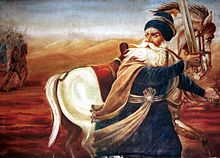Battle of Amritsar (1757)
This article includes a list of general references, but it lacks sufficient corresponding inline citations. (September 2017) |
| Battle of Amritsar | |||||||
|---|---|---|---|---|---|---|---|
| Part of Indian Campaign of Ahmad Shah Durrani | |||||||
 | |||||||
| |||||||
| Belligerents | |||||||
|
|
| ||||||
| Commanders and leaders | |||||||
| Baba Deep Singh † |
Timur Shah Durrani Attal Khan Jahan Khan | ||||||
| Strength | |||||||
| 5000 | 20,000 | ||||||
The Battle of Amritsar was fought between Durrani Empire and Shaheedan Misl of Dal Khalsa on 11 November 1757.[1]
The Battle[]
Ahmad Shah Durrani had finished raiding Hindustan and was returning to Afghanistan after sacking Delhi in January 1757, but on the way his army was attacked by Baba Deep Singh. He managed to escape along with his remaining army and in retaliation for the attack, he attacked Amritsar and desecrated the Golden Temple, the holiest site of the Sikhs, by having waste poured into the pool along with entrails of slaughtered cows in order to hurt the religious sentiment of the Sikhs. Upon his return to Kabul, Abdali sent his son Timur Shah Durrani to chastise the Sikhs. The news of the desecration of the holy Golden Temple had reached Baba Deep Singh so Baba Deep Singh vowed to avenge the desecration of the holiest Sikh site and promised to clean and defend the temple even if it meant sacrificing his own life. Baba Deep Singh, along with an army of 5000 volunteers set off and began marching towards Amritsar, where the Faujdar of Amritsar tried to stop the march with a force of 20,000 soldiers.[2][3][a][4] The Afghan Army fought the Sikh Army at the village of Gohalwar.[5] Baba Deep Singh, the leader of the Sikhs, was killed during the battle.[6][5]
Result of the battle[]
The result of the battle is disputed. According to Professor of Political Science, Tom Lansford, the Sikhs defeated an outnumbered Afghan army.[b][1] While Tony Jacques, states the Sikhs were outnumbered and chased off the Afghan army, yet Baba Deep Singh was killed by Attal Khan.[5] Historical Research fellow Vivek Chadha states that the Sikhs defeated Afghans at the Battle of Amritsar.[7]
Historian J.S. Grewal states that Jahan Khan was nearly overwhelmed by the Sikhs before Afghan reinforcements arrived to save him. [8] Historian Rishi Singh states that Jahan Khan achieved a victory along with the death of Baba Deep Singh.[c][6] The historian Himadri Banerjee states the Sikhs were defeated and many were massacred.[9]
See also[]
Notes[]
- ^ "Five hundred Sikhs did so, and en route to Amritsar their number swelled to five thousand. Five miles from the temple, an army of twenty thousand Afghan soldiers lay in wait for them."[4]
- ^ "The Sikhs and the Afghans later clashed on November 11, 1757, in the Battle of Amritsar (also known as the Battle of Gohalwar). The Sikhs defeated the outnumbered Afghan Army, under the command of Timur Shah Durrani, the son of Ahmad Shah, and forced them to retreat."[1]
- ^ On the other hand, the Sikhs mobilised themselves under the leadership of Baba Deep Singh and marched in gala dresses similar to that of a bridegroom with festal ribbons on their wrists and saffron sprinkled on their robes. The battle took place near Amritsar in which Baba Deep Singh was killed. After his victory, Jahan Khan destroyed and polluted the places of worship of the Sikhs.[6]
References[]
- ^ a b c d Lansford 2017, p. 20.
- ^ Singha 2000, p. 57.
- ^ Singha, H. S (2005). Sikh Studies. Hemkunt Press. p. 36. ISBN 9788170102458.
- ^ a b Barlow 2015, p. 91.
- ^ a b c Jacques 2006, p. 400.
- ^ a b c Singh 2015, p. 65.
- ^ Chadha 2005, p. 171.
- ^ Grewal 1990, p. 91.
- ^ Banerjee 2002, p. 46.
Sources[]
- Banerjee, Himadri (2002). The Khalsa and the Punjab Studies in Sikh History, to the Nineteenth Century. Tulika Books.
- Grewal, J.S. (1990). The Sikhs of the Punjab. Cambridge University Press. p. 91. ISBN 0-521-63764-3. Retrieved 15 April 2014.
- Hoernle, August Friedrich Rudolf; Stark, Herbert Alick (1906). A history of India. Orissa Mission Press. p. 113.
- Jacques, Tony (2006). Dictionary of Battles and Sieges. Greenwood Press. p. 400. ISBN 978-0-313-33536-5. Archived from the original on 2015-06-26. Retrieved 2017-09-14.
- Lansford, Tom (2017). Afghanistan at War: From the 18th-Century Durrani Dynasty to the 21st Century. ABC-CLIO. ISBN 9781598847604.
- Singh, Rishi (2015). State Formation and the Establishment of Non-Muslim Hegemony: Post-Mughal 19th-century Punjab. SAGE Publications.
- Singha, H. S (2000). The encyclopedia of Sikhism (over 1000 entries). Hemkunt Press. p. 107. ISBN 978-81-7010-301-1. Retrieved December 22, 2011.
- Barlow, Hugh D. (2015). Dead for Good: Martyrdom and the Rise of the Suicide Bomber. Taylor & Francis. p. 91. ISBN 9781317261575.
- Chadha, Vivek (2005). Low Intensity Conflicts in India: An Analysis. SAGE Publications. p. 171. ISBN 9780761933250.
- Conflicts in 1758